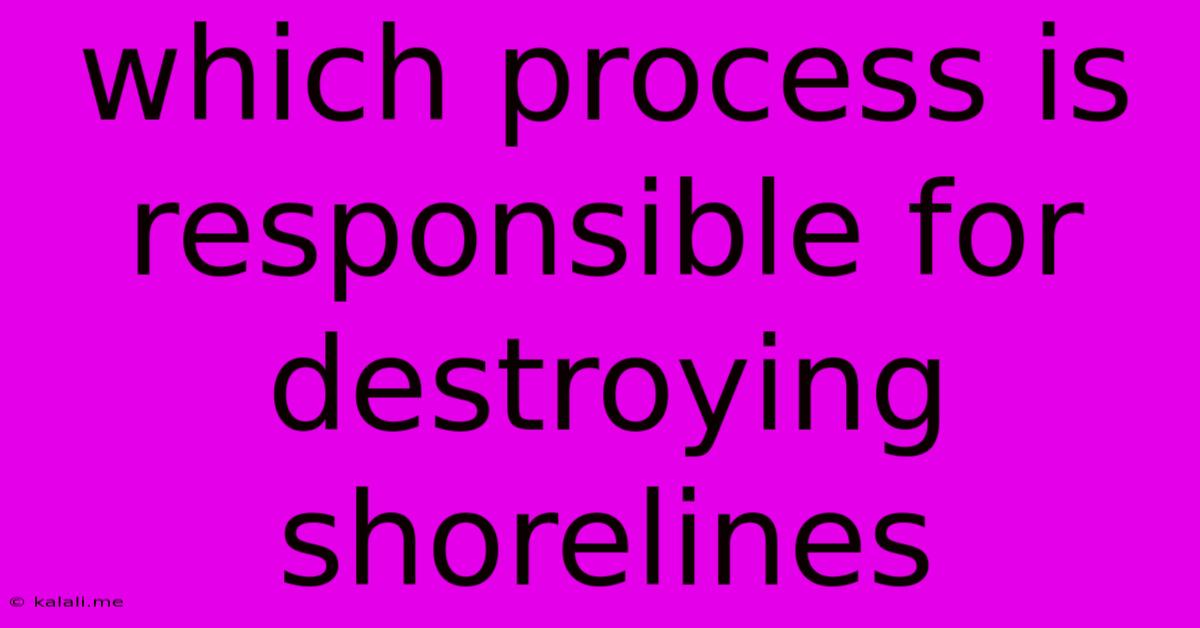Which Process Is Responsible For Destroying Shorelines
Kalali
May 10, 2025 · 3 min read

Table of Contents
Which Processes are Responsible for Destroying Shorelines?
Coastal erosion is a natural process that gradually wears away shorelines. Understanding the forces behind this erosion is crucial for coastal management and protection. This article explores the key processes responsible for the destruction of shorelines, highlighting their individual impacts and the synergistic effects they create. We'll delve into both natural and human-induced factors contributing to shoreline retreat.
Natural Processes Driving Shoreline Erosion:
Several natural forces relentlessly work to reshape coastlines. These include:
1. Wave Action: The Primary Culprit
Waves are the most significant contributors to shoreline erosion. Their constant impact on the coastline generates considerable erosive power. This is further amplified by:
- Hydraulic action: The force of waves compressing air into cracks and crevices within rocks, weakening and eventually breaking them apart.
- Abrasion: The grinding effect of sediment particles carried by waves against the shoreline, essentially sandblasting the coast.
- Attrition: The collision of sediment particles within the waves, causing them to break down into smaller pieces. This creates finer sediment that can be easily transported away.
The intensity of wave action varies based on factors like wind speed, fetch (the distance over which the wind blows), and the seabed topography. High-energy waves, such as those during storms, are particularly effective at eroding shorelines.
2. Tides: The Rhythmic Erosion
Tides play a crucial role, influencing the exposure of shorelines to wave attack and contributing to erosion through:
- Tidal currents: The movement of water during high and low tides can transport sediment away from the coast.
- Intertidal zone exposure: The intertidal zone, the area between high and low tide marks, is constantly exposed to weathering and erosion from various sources.
The magnitude of tidal influence varies geographically, with some areas experiencing significant tidal ranges and others having minimal tidal variation.
3. Sea Level Rise: A Long-Term Threat
Rising sea levels, primarily driven by climate change and thermal expansion of water, significantly exacerbate shoreline erosion. Higher sea levels mean that waves and tides reach further inland, increasing the area exposed to erosion. This long-term process poses a major threat to coastal communities and ecosystems.
4. Weathering: The Gradual Breakdown
Weathering processes, both physical and chemical, contribute to shoreline erosion by weakening coastal materials before they are eroded by waves or tides.
- Physical weathering: Processes like freeze-thaw cycles, where water freezes and expands within cracks, break down rocks.
- Chemical weathering: Reactions between rocks and seawater, such as dissolution and oxidation, weaken coastal materials.
Human-Induced Shoreline Erosion:
Human activities significantly accelerate natural erosion processes:
1. Coastal Development: Construction and its Consequences
Building structures close to the shoreline interrupts natural sediment flow and increases wave energy impacting the coast, intensifying erosion. Removal of coastal vegetation also destabilizes the shoreline, making it more vulnerable.
2. Dam Construction: Sediment Starvation
Dams trap sediment that would otherwise naturally replenish beaches, leading to coastal erosion downstream. This sediment starvation leaves the coast vulnerable to wave attack.
3. Groundwater Extraction: Land Subsidence
Excessive groundwater extraction can cause land subsidence, lowering the land surface and increasing the relative sea level, which makes shorelines more susceptible to flooding and erosion.
Conclusion:
Shoreline erosion is a complex process resulting from the interplay of natural forces and human activities. Understanding the various contributors – wave action, tides, sea level rise, weathering, and human interventions – is fundamental for developing effective strategies to mitigate coastal erosion and protect vulnerable shorelines. Integrated coastal zone management approaches, incorporating sustainable development practices and nature-based solutions, are essential for preserving coastal environments.
Latest Posts
Latest Posts
-
How Many Teaspoons In A Pound Of Sugar
Jul 12, 2025
-
How Do You Pass Level 12 On Bloxorz
Jul 12, 2025
-
How Far Is 0 4 Miles To Walk
Jul 12, 2025
-
What Is 20 Percent Of 800 000
Jul 12, 2025
-
Words That Start With Y In Science
Jul 12, 2025
Related Post
Thank you for visiting our website which covers about Which Process Is Responsible For Destroying Shorelines . We hope the information provided has been useful to you. Feel free to contact us if you have any questions or need further assistance. See you next time and don't miss to bookmark.